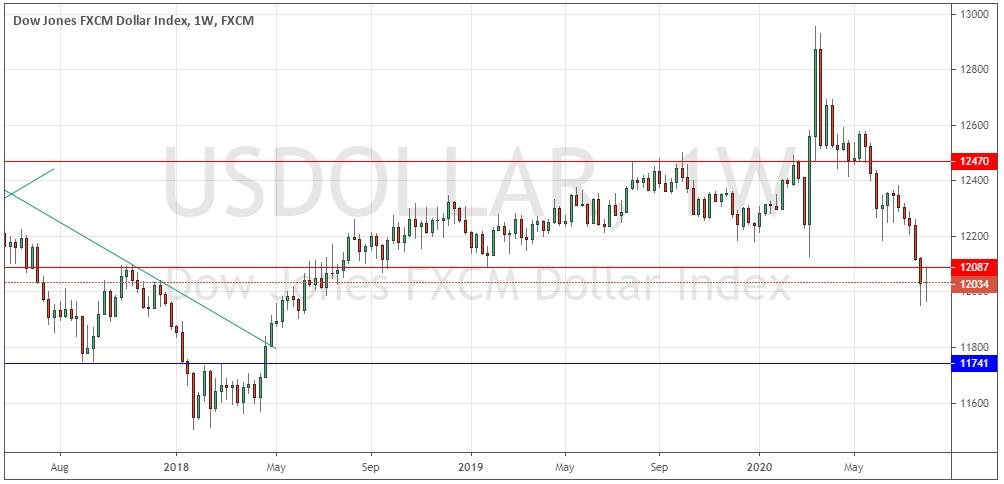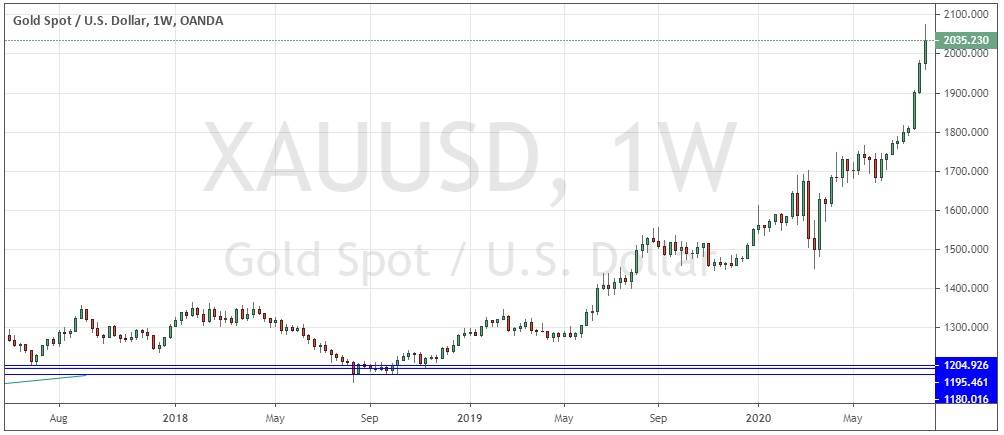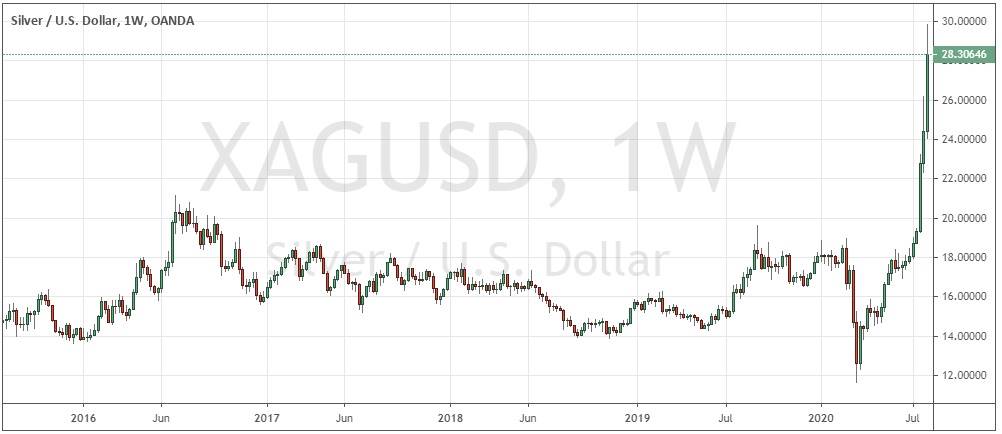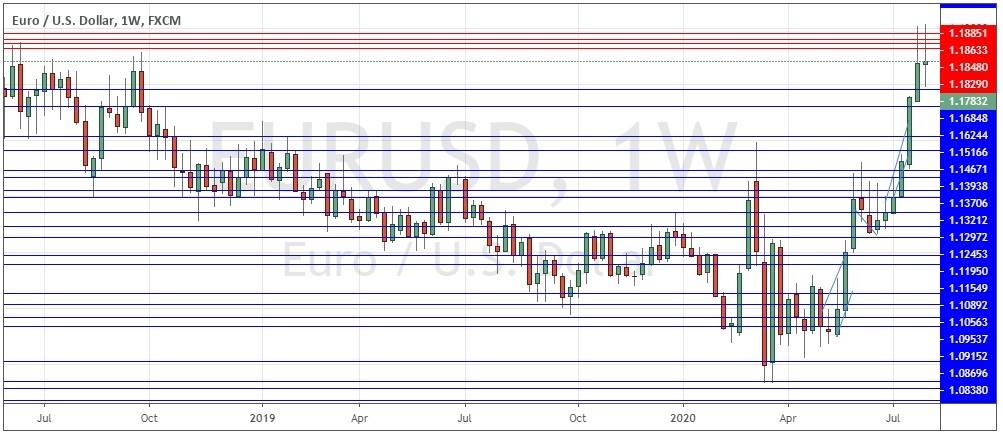The difference between success and failure in Forex trading is very likely to depend upon which currency pairs you choose to trade each week, and not on the exact trading methods you might use to determine trade entries and exits. The current market environment has changed from one of crisis to a questionable rebound or recovery, despite the continuing growth in the coronavirus pandemic which is still sweeping the world.
Big Picture 9th August 2020
In my previous piece last week, I saw the most attractive trade set-ups as likely to be long of Gold and Silver (following a daily close above $24.61) in U.S. Dollar terms as each half of one unit, and long of EUR/USD (following a daily close above 1.1847) as another unit. This was a very profitable call, as gold rose by 3.00% over the week, Silver by 8.87% after closing at $26.00 on Tuesday, but the EUR/USD fell by 0.67% after closing on Wednesday at 1.1863. This produced a very strong overall result for the week of a 5.27% portfolio gain.
Last week’s Forex market saw the strongest rise in the relative value of the Swiss Franc and the strongest fall in the relative value of the New Zealand Dollar.
Fundamental Analysis & Market Sentiment
The world is not coming to an end, but we are living in an extraordinary time of global health crisis, the magnitude of which has not been seen in over one hundred years. The vast majority of people are going to survive and be healthy, yet the impact of the crisis still dominates the global economy, as the virus is appearing to be resurgent even in countries that had initial success in suppressing its spread.
The economic impact of the virus seems to be transferring income streams from smaller to larger businesses and boosting the profitability of large tech companies.
Last week saw daily new confirmed coronavirus cases hold up just below its all-time high. This is a sign that globally, the wave of the disease may well still be advancing to a peak.
We have seen the epicenter of the global coronavirus pandemic move into Latin America, although the U.S.A. has recently overtaken Brazil to again become the country with the highest average number of daily deaths from the virus. The rolling averages of deaths have decreased significantly in Europe. However, the U.S.A. has seen a sharp increase in new cases over recent weeks in many states, with the worst-affected states in the Midwest. Cases are also rising in Asia, especially India.
Latin America and the Caribbean are now responsible for approximately 45% of confirmed new daily deaths, with the U.S.A. at 18% and Europe at about 6%. The strongest growth in new confirmed cases is happening in Albania, Argentina, Australia, Bahamas, Belgium, Bolivia, Bosnia, Brazil, Bulgaria, Colombia, Costa Rica, Cuba, Czech Republic, Denmark, Ecuador, El Salvador, Greece, India, Indonesia, Iraq, Israel, Jamaica, Japan, Kenya, Lebanon, Moldova, Nepal, Netherlands, Paraguay, Philippines, Poland, Romania, Senegal, Slovakia, Spain, Ukraine, Uzbekistan, Venezuela, and Vietnam.
The U.S. stock market rose a little last week to make its highest weekly close since February, and it's second-highest close of all time. The S&P 500 Index is now close to the all-time high made early in 2020. Although last Friday’s non-farm payroll data appeared superficially stronger than had been expected, there are worrying indications of a renewed economic slowdown in the U.S. over recent weeks in the most up to date data. There is also concern about the persistence of unemployment from earlier closures and restrictions and the economic impact of the reversals of easing which are now being imposed in several states. However, the market still hopes to see an additional and far-reaching stimulus package from the federal government soon, despite the current political impasse.
The U.S. Dollar was unchanged overall last week, while precious metals again rose strongly, although not quite as strongly as they did over the previous week. There is an increasing feeling that the Eurozone economy may be better placed to recover from the economic impact of the coronavirus than the U.S. economy, which has helped boost the Euro against the U.S. Dollar.
The coming week will bring a few important releases concerning major currencies: as well as U.S. inflation data, we will get central bank input from New Zealand and British GDP data.
Technical Analysis
U.S. Dollar Index
The weekly price chart below shows last week printed a doji candlestick very close to a long-term low price. There is finally a long-term bearish trend, as the price is lower than it was both 3 and 6 months ago. The problems for bears are that although the price has broken below the 12087 area which has provided support since early 2019, we are seeing a reluctance by the Dollar to fall further, as evidenced by the indecisive weekly doji candlestick. However, overall, next week’s price movement in the U.S. Dollar looks very slightly more likely to be downwards than upwards.
Gold
Last week printed a large bullish candlestick which closed at a new all-time high weekly closing price, which are bullish signs. The price also closed above the big round number at $2,000 which is also bullish However, the close was not near the high of the range, which is a slightly bearish sign. I again see that it is time to trade Gold in the long direction, but only following a daily close above $2,064.
Silver
Last week printed a very large bullish candlestick, which closed at a new 7-year high weekly closing price. However, the price did close a little off the high of its weekly range after peaking on Thursday. These are mostly bullish signs and other precious metals such as Gold are also advancing against the U.S. Dollar. However, I want to see a daily (New York) close above $28.90 before going long. There is a good chance that the price of Silver will rise over the coming week, in fact, I am more optimistic about Silver than Gold now.
EUR/USD
Last week printed a fairly large doji candlestick, which closed at a new 2-year high weekly closing price. This is both somewhat bullish, but essentially suggests indecisive price action. The long-term bullish trend is intact, but bulls need to be careful, as we may be near the end of this bullish movement. I am prepared to take a long trade, but I want to see a daily (New York) close above 1.1876 before going long.
Bottom Line
I again see the most attractive trade set-ups for this week as likely to be long of Gold and Silver in U.S. Dollar terms, and long EUR/USD, with each as only one-third of a unit Silver should only be entered after a New York close above $28.90, Gold after a New York close above $2,064, and EUR/USD after a New York close above 1.1876.





